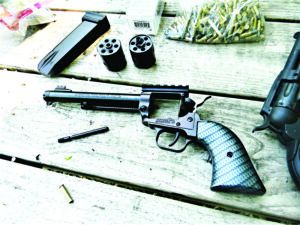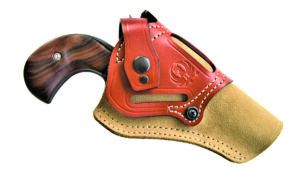Most handgunners own a rimfire revolver or two and appreciate them as affordable and enjoyable plinkers, useful for informal target practice, firing at tin cans, dirt clods, and other stuff on a range backstop (where allowed). Such revolvers allow for cheap and easy marksmanship training, and because of their manual of arms, they make it clear to a new shooter how everything works, because the shooter is involved in working the gun on every shot. Many shooters also use rimfire revolvers for small-game hunting, if they are accurate enough to take a bedded rabbit or knock a squirrel from a tall tree. Rimfire revolvers are also useful for controlling pests and dangerous reptiles. So, because of these guns’ utility, our Gun Tests shooters fired three contenders side by side to see which one they thought was the better buy. All three have cowboy styling, although one is a double-action revolver intended to mimic the handling and handfit of a single-action revolver.
Our first contestant was Diamondback’s Sidekick DB0500A001 22 LR/22 WMR, $288. This is a relatively new handgun that handles like the vintage High Standard Double Nine. As its name suggests, the Diamondback revolver was delivered with an easily changed spare cylinder chambered in 22 Magnum.
Our second gun was likewise a twin chambering of the 22 LR/22 Magnum rounds. The Heritage Rough Rider Tactical Cowboy RR22B6-TH 22 LR/22 Magnum, $212, is unusual in that this cowboy-looking handgun has a threaded muzzle and carbon-fiber grips, lending it a very contemporary look. When he first saw this gun, the staffer who ran this test asked, “What will you do with that?” After using the Heritage Cowboy Tactical a few weeks, he ate crow. We paid full MSRP for one of the first of these revolvers, but recently we have seen several on sale for less than $175. Add shipping and FFL receiving fees, and it’s safe to say you should be able to find one of these revolvers for around $200. The Heritage revolver did not come with a 22 Magnum cylinder, but we added one for $29 plus tax from our local Academy Sports, for a total price of $241. The cylinder did not require fitting, a neat trick.
The third gun in the trio was Ruger’s Wrangler Birdshead 2030 22 LR, $250. This is a Talo Distributor Exclusive model. The standard birdshead Model No. 2015 has synthetic grips. Ruger introduced the Wrangler as a direct competitor to Heritage’s Rough Rider series, but Ruger cannot match Heritage’s price point, but Ruger has sold plenty of inexpensive Wrangler revolvers. In contrast to the two guns above, there isn’t a Magnum cylinder option offered for the Wrangler because Ruger cylinders must be fitted at the factory.
Accordingly, we test-fired the Diamondback and Heritage revolvers with 22 Magnum cartridges using CCI and Federal ammunition. The accuracy results obtained were in line with the 22 Long Rifle testing, with the Heritage revolver being slightly more accurate. But if you look at the energy calculations, some Magnum loads have twice the energy of the 22 LRs. During the test period, we used 40-grain lead round-nose 22 Long Rifle high-velocity loads from Federal, Fiocchi, Remington and Winchester, firing 200 rounds in each revolver. We also had a range bag of suspect tarnished loads from another test that we used up, and which you might see in some of the filled cylinders. They all fired without a hitch, and we didn’t have to leave the range rubbing our wrists after firing 600 rounds offhand. With the 22 rimfire, practice is fun and not painful. Here’s what we thought about each gun in more detail.
Gun Tests Grade: C
$250
The Wrangler Birdshead is the first shorter-barrel Wrangler with a 3.75-inch barrel length. It seems that the versions supplied with DeSantis Wild Hog holster cost about $10 over the versions without the holster. That is a very good deal, in our view, and we appreciated having the holster ready to go with the pistol.
| Action Type | Single action only, hammer fired |
| Overall Length | 8.62 in. |
| Overall Height | 4.0 in. |
| Maximum Width | 1.5 in. |
| Weight Unloaded | 28.0 oz. |
| Weight Loaded | 31.8 oz. |
| Cylinder Gap | 0.06 in. |
| Barrel Length | Alloy steel, 3.75 in. long, 1:14 RH twist, 6 grooves |
| Capacity | 6 |
| Frame | alloy |
| Cylinder Frame | Cobalt Cerakote aluminum alloy |
| Frame Front Strap Height | 1.95 in. |
| Frame Rear Strap Height | 3.0 in. |
| Grips | Birdshead Hardwood |
| Grip Thickness Max | 1.65 in. |
| Grip Circumference | 5.5 in. |
| Front Sight | Fixed Blade |
| Rear Sight | Receiver top groove |
| Sight Radius | 3.86 in. |
| Trigger Pull Weight Single Action | 4.25 lbs. |
| Trigger Span | 2.9 in. |
| Safety | None |
| Warranty | None written |
| Website | Ruger.com |
| Telephone | (336) 949-5200 |
| Made In | U.S. |

The Ruger Wrangler Birdshead’s grip-frame style was originally used with the Colt Lightning and a few other early revolvers. The birdshead is a visually pleasing grip that readily accommodates most hand sizes. The birdshead grip seems to allow quickly cocking the hammer with greater ease than most grip frames. The birdshead grip frame seems best suited to shorter-barrel revolvers. Notably, Heritage also offers several birdshead versions of the Rough Rider revolver as well as offering birdshead conversion kits. The Ruger’s wooden grips are very nicely finished. Fit of the frame to the wood is excellent. Unlike the steel-frame Ruger Single Six, the Wrangler is manufactured with an inexpensive aluminum-alloy frame. The 22 rimfire isn’t a high-pressure number and steel isn’t necessary, save in the barrel and cylinder.
The Wrangler single action operates differently from most other single-action revolvers. You do not have to put the hammer on half cock to open the loading gate. Simply leave the hammer down and open the loading gate. The revolver cylinder then free wheels. Load six cartridges to fire, and after firing, open the loading gate and use the barrel-mounted ejector rod to kick spent cartridge cases out one at a time as you index each chamber individually.
The Wrangler is Cerakote finished, and a variety of colors are offered. Our example is gray. While the material used to build the frame may be zinc based, the barrel is cold-hammer-forged steel. The Wrangler, like all other Ruger revolvers, features a transfer bar safety lever action. The revolver is safe to carry fully loaded with a loaded cylinder under the hammer. The Wrangler features a coil spring action. Coil springs are far superior to the old leaf-type spring once used in single-action revolvers.

While it is a solid recreational firearm that simply reeks of Gunsmoke and the Old West, the Birdshead Wrangler isn’t a toy. No firearm is. Don’t cock the hammer in the holster and don’t engage in fast-draw presentations until you have a ton of dry-fire practice under your gun belt. The hammer should only be cocked after the revolver is up, on target, and aimed in a safe direction. Out of the holster, the Ruger handles well. As far as speed shooting goes, the Ruger Wrangler Birdshead is very fast. Fast snap-shooting at 3 to 5 yards gave us good center hits.
The problem came in firing for accuracy. Even at the limited range of 15 yards, the Ruger was difficult to fire accurately. The old-style sights are simply a groove in the top strap. The grey finish and the small sights caused the sights to fade away with all three raters. The pistol has intrinsic accuracy, but practical accuracy is more difficult to come by when you can’t put the sights in the middle of target consistently. We used 40-grain loads for accuracy testing but added the CCI Stinger 32-grain high-velocity loading as well. We managed a single five-shot group of 1.9 inches, outstanding accuracy for this type of plinker, but most groups were larger.
Our Team Said: The Ruger Wrangler Birdshead Talo Exclusive was reliable with all ammunition tested, and it handles well. But the sights suffered in comparison to the other revolvers. Thus, the Ruger Wrangler Birdshead isn’t well suited to marksmanship training or small-game hunting. Also, there is no Magnum cylinder option.
22 LR Range Data
We fired all groups of 22 LR above and 22 Magnum left at 15 yards from a braced benchrest position using an MTM Universal Shooting rest. We used a Competition Electronics Pro Chrony to measure velocity, with the first screen of the chronograph 10 feet from the muzzles of the firearms.| Remington Thunderbolt 40-grain RNL | Heritage Tactical Cowboy | Diamondback Sidekick | Ruger Wrangler Birdshead |
| Average Velocity | 991 fps | 940 fps | 929 fps |
| Muzzle Energy | 87 ft.-lbs. | 78 ft.-lbs. | 77 ft.-lbs. |
| Small group | 1.5 in. | 2.0 in. | 3.0 in. |
| Average Group | 2.1 in. | 2.45 in. | 4.0 in. |
| Fiocchi Performance 40-grain CRN | Heritage Tactical Cowboy | Diamondback Sidekick | Ruger Wrangler Birdshead |
| Average Velocity | 1006 fps | 989 fps | 960 fps |
| Muzzle Energy | 90 ft.-lbs. | 87 ft.-lbs. | 82 ft.-lbs. |
| Small group | 1.4 in. | 2.2 in | 2.9 in. |
| Average Group | 1.75 in. | 2.7 in. | 3.6 in. |
| CCI Mini-Mag 36-grain | Heritage Tactical Cowboy | Diamondback Sidekick | Ruger Wrangler Birdshead |
| Average Velocity | 1112 fps | 1101 fps | 978 fps |
| Muzzle Energy | 99 ft.-lbs. | 97 ft.-lbs. | 76 ft.-lbs. |
| Small group | 1.8 in. | 2.0 in. | 2.8 in. |
| Average Group | 2.4 in. | 2.7 in. | 3.45 in. |
22 Magnum Range Data
We fired all groups of 22 LR above and 22 Magnum left at 15 yards from a braced benchrest position using an MTM Universal Shooting rest. We used a Competition Electronics Pro Chrony to measure velocity, with the first screen of the chronograph 10 feet from the muzzles of the firearms.| Hornady Critical Defense 45-grain FRX 83200 | Heritage Tactical Cowboy | Diamondback Sidekick |
| Average Velocity | 1160 fps | 1150 fps |
| Muzzle Energy | 134 ft.-lbs. | 132 ft.-lbs. |
| Small Group | 1.25 in. | 2.5 in. |
| Average Group | 1.65 in. | 3.4 in. |
| CCI Maxi-Mag 46-grain Polymer-Coated SHP | Heritage Tactical Cowboy | Diamondback Sidekick |
| Average Velocity | 1201 fps | 1186 fps |
| Muzzle Energy | 147 ft.-lbs. | 144 ft.-lbs. |
| Small Group | 1.8 in. | 2.0 in. |
| Average Group | 2.4 in. | 2.6 in. |

























